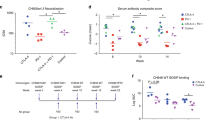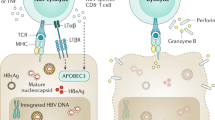Abstract
Adoptive transfer of immunity against hepatitis B surface antigen (HBsAg) has been documented in mice and humans. In the present study, we report long-term follow-up of antibodies to HBsAg in humans who received allogeneic bone marrow transplantation (BMT) from donors immunized with HBsAg. BM donors were immunized with recombinant HBsAg. BM or PB cells were transplanted to HLA matched recipients. Recipients were followed for anti-HBs seroconversion. Control groups included non-immunized or rHBsAg immunized healthy adults as well as individuals that had had hepatitis B and recovered spontaneously. PBLs were stimulated in vitro with rhbsag and stimulation was expressed as stimulation index. adoptive transfer of immunity to hbsag was initially documented in 12 recipients of bm from anti-hbc+/anti-hbs+ donors. an almost 4 year follow-up showed detectable protective anti-hbs levels (>10 mIU/ml) in 50% of patients. Immunity to HBV was also documented in 22/35 BMT recipients (62%), who received their bone marrow from actively immunized donors. In 7/9 of these BMT recipients, anti-HBs antibodies levels were documented 25 months following BMT. In 6/8 (75%) of patients who received only PBLs from HBV immune donors, adoptive transfer of immunity to HBV, and seroconversion to HBsAg+, were documented within 2 months of i.v. injection. Evidence for specific cellular immune response with increased SIs was documented for healthy vaccinees, and BMT recipients, and in none of the healthy non-vaccinated controls. These results suggest that adoptive transfer of immunity to HBV is a useful method for providing long-lasting protection for BM recipients. Bone Marrow Transplantation (2000) 26, 633–638.
This is a preview of subscription content, access via your institution
Access options
Subscribe to this journal
Receive 12 print issues and online access
$259.00 per year
only $21.58 per issue
Buy this article
- Purchase on Springer Link
- Instant access to full article PDF
Prices may be subject to local taxes which are calculated during checkout



Similar content being viewed by others
References
Alter M, Mast EE . The epidemiology of viral hepatitis in the United States Gastro Clin North Am 1994 23: 437–455
Margolis H, Alter M, Hadler S . Hepatitis B: evolving epidemiology and implications for control Sem Liver Dis 1991 11: 84–91
Chisari FV, Ferrari C . Hepatitis B virus immunopathogenesis Annu Rev Immunol 1995 13: 29–34
Blum H, Liang T, Galun E, Wands J . Persistence of hepatitis B viral DNA after serological recovery from hepatitis B virus infection Hepatology 1991 14: 56–61
Ganem D . Persistent infection of humans with hepatitis B virus: mechanisms and consequences Rev Infect Dis 1982 4: 1026–1031
Devergie A, Brechot C, Schenmetler C, Bernu J . Fulminant hepatitis due to reactivation of chronic hepatitis B virus infection after allogeneic bone marrow transplantation Dig Dis Sci 1988 33: 1185–1189
Strasser SI, McDonald GB . Hepatitis viruses and hematopoietic cell transplantation: a guide to patient and donor management Blood 1999 93: 1127–1131
Lum LG . The kinetics of immune reconsititution after allogeneic human marrow transplantation Blood 1987 69: 369–394
Locasciulli A, Alberti A, Bandini G et al. Allogeneic bone marrow transplantation from HbsAg+ donors: a multicenter study from the Gruppo Italiano Trapianto di Midolol Osseo (GITMO) Blood 1995 86: 3236–3240
Whitherspoon RP, Strob R, Ochs HD et al. Recovery of antibody production in human allogeneic marrow graft recipients: influence of time post transplantation, the presence or absence of chronic graft versus host disease, and anti-thymocyte globulin treatment Blood 1981 58: 360–366
Rosendhal C, Bender-Goetze D, Deinhardt F et al. Immunization against hepatitis B in BMT and leukemia patient Exp Hematol 1985 13: 104–108
Winston DJ, Ho WG, Schiffman G et al. Pneumoccocal vaccination of recipients of bone marrow transplants Arch Int Med 1983 143: 1735–1737
Gottlieb DJ, Cryz SJ, Furer E et al. Immunity against Pseudomonas aeruginosa transferred to bone marrow transplants recipients Blood 1990 76: 2470–2472
Saxon A, Stevens R, Champlin RE et al. Designed transfer of specific immune responses with bone marrow transplantation J Clin Invest 1986 78: 959–967
Wimperis JZ, Brenner MK, Prentice HG et al. A transfer of functioning humoral immune system in transplantation of T lymphocytic depleted bone marrow Lancet 1986 15: 339–347
Greenberg PD . Adoptive T cell therapy of tumors: mechanisms operative in the recognition and elimination of tumor cells Adv Immunol 1991 49: 281–355
Riddell SR, Greenberg PD . Principles for adoptive T cell therapy of human viral disease Annu Rev Immunol 1995 13: 545–586
Riddell SR, Watanabe KS, Goodrich JM et al. Restoration of viral immunity in immunodeficient humans by adoptive transfer of T cell clones Science 1992 257: 238–241
Walter EA, Greenberg PD, Gilbert MJ . Reconsititution of cellular immunity against CMV in recipients of allogeneic bone marrow by transfer of T-cell clones from the donor New Engl J Med 1995 333: 1038–1044
Shouval D, Adler R, Ilan Y . Adoptive transfer of immunity to hepatitis B virus in mice by bone marrow transplantation from HBV immune donors Hepatology 1993 17: 955–959
Shouval D, Ilan Y . Adoptive transfer of immunity to hepatitis B: development of the concept and evolution of the research project for targeted immunotherapy against hepatic cells which express a viral antigen Adv Drug Delivery Rev 1995 17: 317–320
Reusser P, Riddell SR, Meyers JD, Greenberg PD . Cytotoxic T-lymphocytes response to cytomegalovirus after human allogeneic bone marrow transplantation: pattern of recovery and correlation with CMV infection and disease Blood 1991 78: 1373–1380
Li CR, Greenberg PD, Gilbert MJ et al. Recovery of HLA-restricted cytomegalovirus-specific T cell response after allogeneic bone marrow transplant: correlation with CMV disease and effect of gancyclovir prophylaxis Blood 1994 83: 1971–1979
Murray RJ, Kurilla MG, Brooks JM . Identification of target antigens for the human cytotoxic T cell response to Epstein Barr virus: Implications for the immune control of EBV positive malignancies J Exp Med 1992 176: 157–168
Khanna R, Birrows SR, Kurilla MG . Localization of Epstein Barr virus cytotoxic T cell epitopes using recombinant vaccinia. Implication for vaccine development J Exp Med 1992 176: 169–176
Levitskaya J, Coram M, Levitsky V . Inhibition of antigen processing by the internal repeat region of the EBV nuclear antigen-1 Nature 1995 375: 685–688
Papadopoulus EB, Ladanyi M, Emanuel D . Infusions of donor leukocytes to treat EBV-associated lymphoproliferative disorders after allogeneic bone marrow transplantation New Engl J Med 1994 330: 1185–1191
Bourgault I, Gomez A, Gomard E, Levy JP . Limiting-dilution analysis of the HLA restriction of anti-EBV specific cytolytic T lymphocytes Clin Exp Immunol 1991 84: 501–507
Heslop HE, Rooney CM . Adoptive cellular immunotherapy for EBV lymphopoliferative disease Immun Rev 1997 157: 217–222
O'Reilly RJ, Lacerda JF, Lucas KG et al. Adoptive cell therapy with donor lymphocytes for EBV-associated lymphomas developing after allogeneic marrow transplants Important Adv Oncol 1996 66: 149–166
Lau GK, Liang R, Lee CK et al. Clearance of persistent hepatitis B virus infection in Chinese bone marrow transplant recipients whose donors were anti-hepatitis B core and anti-hepatitis B surface antibody-positive J Infect Dis 1998 178: 1585–1591
Lau GK, Lok AS, Liang RH et al. Clearance of hepatitis B surface antigen after bone marrow transplantation: role of adoptive immunity transfer Hepatology 1997 25: 1497–1501
Ilan Y, Nagler, A, Adler, R et al. Adoptive transfer of immunity to hepatitis B in humans following T-depleted bone marrow transplantation from HBV immune donors Hepatology 1993 18: 246–252
Ilan Y, Nagler A, Ackerstein A et al. Development of antibodies to hepatitis B virus surface antigen in bone marrow transplant recipient following treatment with peripheral blood lymphocytes from immunized donors Clin Exp Immunol 1994 97: 299–302
Shouval D, Ilan Y . Transplantation of hepatitis B immune lymphocytes as means for adoptive transfer of immunity to HBV J Hepatol 1995 23: 98–101
Ilan Y, Nagler A, Adler R et al. Ablation of persistent hepatitis B by allogeneic bone marrow transplantation from an HBV immune donor Gastroentrol 1993 104: 1818–1821
Hollinger F, Dreesman G, Morrison M, Meinick J . Improved double antibody radioimmunoassay (RIA-DA) methodology for detecting hepatitis B antigen and antibody Am Soc Microbiol 1972 72: 213 (Abstr.)
Rehermann B, Lau D, Hoofnagle JH, Chisari FV . Cytotoxic T Lymphocyte responsiveness after resolution of chronic hepatitis B virus infection J Clin Invest 1996 97: 1655–1665
Chisari FV . Cytotoxic T cells and viral hepatitis J Clin Invest 1997 99: 1472–1477
Lau GK, Liang R, Lee CK, Lim WL . Is vaccination of donor adequate for clearance of hepatitis B virus after bone marrow transplantation? Lancet 1997 349: 1626–1627
Ilan Y, Gabay E, Amit G et al. Suppression of human hepatoma in mice through adoptive transfer of immunity to hepatitis B surface antigen J Hepatol 1997 27: 176–179
Acknowledgements
This study was supported by The Ministry of Health, Chief Scientist, grant No. 2013, and the joint research fund of the Hebrew University and Hadassah, and the L Naftali Research Foundation.
Author information
Authors and Affiliations
Rights and permissions
About this article
Cite this article
Ilan, Y., Nagler, A., Zeira, E. et al. Maintenance of immune memory to the hepatitis B envelope protein following adoptive transfer of immunity in bone marrow transplant recipients. Bone Marrow Transplant 26, 633–638 (2000). https://doi.org/10.1038/sj.bmt.1702571
Received:
Accepted:
Published:
Issue Date:
DOI: https://doi.org/10.1038/sj.bmt.1702571
Keywords
This article is cited by
-
A prospective trial of vaccine to prevent hepatitis B virus reactivation after hematopoietic stem cell transplantation
Bone Marrow Transplantation (2020)
-
Impfen bei Immundefizienz
Bundesgesundheitsblatt - Gesundheitsforschung - Gesundheitsschutz (2020)
-
Role of Immunomodulators in Functional Cure Strategies for HBV
Current Hepatology Reports (2020)
-
Control of hepatitis B virus infection in hematopoietic stem cell recipients after receiving grafts from vaccinated donors
Bone Marrow Transplantation (2016)
-
Advances in therapeutics for chronic hepatitis B
Hepatology International (2016)



